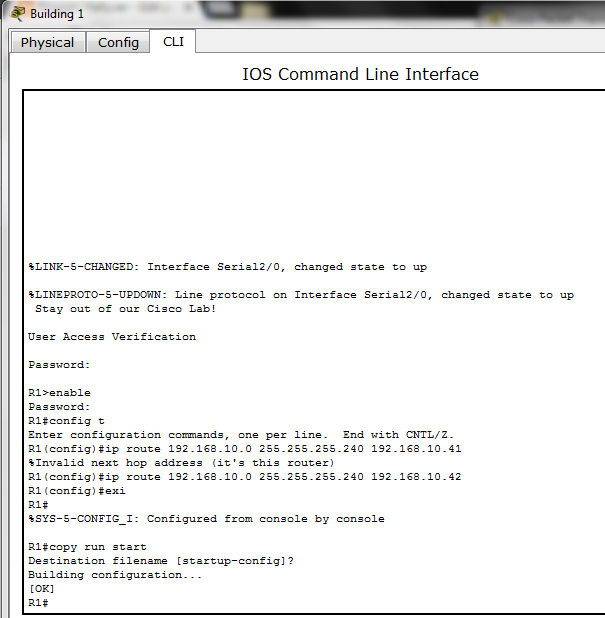VLSM
Subnet the given network with the following
requirements:
192.168.10.0
Building 1:
·
IT – 3 PCs
·
Office – 8 PCs
Building 2:
·
Sales – 10 PCs
Routers-to-Routers – 2TPs
Solution:
SALES – 10 PCs [16-2=14] 44 à S4
OFFICE – 8 PCs [16-2=14] 44 à S4
IT – 3 PCs [8-2=6] 43 à S5
Router – 2TPs [4-2=2] 42 à S4
Network
Address
|
Host
Range
|
Broadcast
Address
|
Subnet
Mask
|
192.168.10.0
|
192.168.10.1 - 192.168.10.14
|
192.168.10.15
|
255.255.255.240
|
192.168.10.16
|
192.168.10.17 - 192.168.10.30
|
192.168.10.31
|
255.255.255.240
|
192.168.10.32
|
192.168.10.33 - 192.168.10.38
|
192.168.10.39
|
255.255.255.248
|
192.168.10.40
|
192.168.10.41 - 192.168.10.42
|
192.168.10.43
|
255.255.255.252
|
Router, Network and VLAN Table
Vlan table - Sales, office and It
Network - PCs
Router Table - Building 1 and Building 2 network
Device
|
Interface
|
IP Address
|
Subnet Mask
|
Default Gateway
|
Sales
|
Vlan 1
|
192.168.10.14
|
255.255.255.240
|
192.168.10.1
|
PC 1
|
NIC
|
192.168.10.2
|
255.255.255.240
|
192.168.10.1
|
PC 2
|
NIC
|
192.168.10.3
|
255.255.255.240
|
192.168.10.1
|
PC 3
|
NIC
|
192.168.10.4
|
255.255.255.240
|
192.168.10.1
|
PC 4
|
NIC
|
192.168.10.5
|
255.255.255.240
|
192.168.10.1
|
PC 5
|
NIC
|
192.168.10.6
|
255.255.255.240
|
192.168.10.1
|
PC 6
|
NIC
|
192.168.10.7
|
255.255.255.240
|
192.168.10.1
|
PC 7
|
NIC
|
192.168.10.8
|
255.255.255.240
|
192.168.10.1
|
PC 8
|
NIC
|
192.168.10.9
|
255.255.255.240
|
192.168.10.1
|
PC 9
|
NIC
|
192.168.10.10
|
255.255.255.240
|
192.168.10.1
|
PC 10
|
NIC
|
192.168.10.11
|
255.255.255.240
|
192.168.10.1
|
Office
|
Vlan 1
|
192.168.10.30
|
255.255.255.240
|
192.168.10.17
|
PC 1
|
NIC
|
192.168.10.18
|
255.255.255.240
|
192.168.10.17
|
PC 2
|
NIC
|
192.168.10.19
|
255.255.255.240
|
192.168.10.17
|
PC 3
|
NIC
|
192.168.10.20
|
255.255.255.240
|
192.168.10.17
|
PC 4
|
NIC
|
192.168.10.21
|
255.255.255.240
|
192.168.10.17
|
PC 5
|
NIC
|
192.168.10.22
|
255.255.255.240
|
192.168.10.17
|
PC 6
|
NIC
|
192.168.10.23
|
255.255.255.240
|
192.168.10.17
|
PC 7
|
NIC
|
192.168.10.24
|
255.255.255.240
|
192.168.10.17
|
PC 8
|
NIC
|
192.168.10.25
|
255.255.255.240
|
192.168.10.17
|
IT
|
Vlan 1
|
192.168.10.38
|
255.255.255.248
|
192.168.10.33
|
PC 1
|
NIC
|
192.168.10.34
|
255.255.255.248
|
192.168.10.33
|
PC 2
|
NIC
|
192.168.10.35
|
255.255.255.248
|
192.168.10.33
|
PC 3
|
NIC
|
192.168.10.36
|
255.255.255.248
|
192.168.10.33
|
Building 1
|
||||
IT
|
Fa0/0
|
192.168.10.33
|
255.255.255.248
|
N/A
|
Office
|
Fa1/0
|
192.168.10.17
|
255.255.255.240
|
N/A
|
Se2/0
|
192.168.10.41
|
255.255.255.252
|
N/A
|
|
Building 2
|
||||
Sales
|
Fa0/0
|
192.168.10.1
|
255.255.255.240
|
N/A
|
Se2/0
|
192.168.10.42
|
255.255.255.252
|
N/A
|
*Notes: NIC - Network Interface Card
VLAN IP Address is always the last valid host of the network.
i.e IT Vlan 1 - IP Address is 192.168.10.38, the last valid host.
PC IP Address usually have 'running' address. in range from the valid host range
For the Router, the IP Address of the fastEthernet is the default gateway of the switch
i.e IT Fa0/0, th eIP Address is 192.168.10.33, which is the dafault gateway for the IT Switch
IP Route Table
Network Name
|
Network Address
|
Subnet Mask
|
First Hop IP
|
Building 1
|
|||
Sales
|
192.168.10.0
|
255.255.255.240
|
192.168.10.42
|
Building 2
|
|||
Office
|
192.168.10.16
|
255.255.255.240
|
192.168.10.41
|
IT
|
192.168.10.32
|
255.255.255.248
|
192.168.10.41
|
For the first hop ip, get the ip address router.
i.e building 1, get serial address (Se2/0) of building 2, vice versa
i.e building 1, get serial address (Se2/0) of building 2, vice versa
















